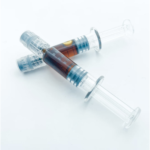To truly differentiate their product, brands should start talking less about strains and more about terpenes.
Cannabis cultivars come in a full spectrum of aromatic and therapeutic profiles. Some strains smell like fresh citrus and deliver energizing effects, others evoke lavender’s soothing scent and properties.
And it’s all because of terpenes.
Terpenes, or “terps” in colloquial terms, have a massive influence over cannabis, and in our opinion, they’re under-utilized marketing tools that can give brands a competitive advantage.
But too often brands, and those who sell cannabis, separate cannabis into two categories: Indicas and Sativas. This is an old way of thinking about the plant that we need to retire.
Terpenes are the true differentiator. Here is an overview of hemp and cannabis terpenes, their effects, and why terpene testing is imperative for cannabis and hemp marketing.
What are terpenes?
Terpenes are fragrant oils in plants. Their purpose is to lure in pollinators or repel hungry predators. Essentially, terps are a plant’s built-in defense system. Terpenes aren’t exclusive to cannabis; they’re present in all plant types, from fragrant flowers to hearty vegetables.
Researchers have recognized more than 100 terpenes in cannabis, though some are only present in trace amounts. Each terpene works with cannabinoids and flavonoids to make up a strain’s unique identity. Terpenes also work in tandem with cannabinoids like THC and CBD to heighten the therapeutic properties and minimize adverse effects. This synergetic process is described as the “Entourage Effect.”
Terpenes’ unique cannabis benefits
Studies have shown that the terpenes work with the full spectrum of plant compounds to deliver each cultivar’s distinct effects. Because just like cannabinoids, terpenes can cross the blood-brain barrier. Some of the more common cannabis terpenes include:
- Myrcene: Earthy scent with calming and sedative effects. It can sometimes be mood-boosting in smaller amounts.
- Limonene: Citrusy scent with antioxidant properties. Also found in citrus fruits, like oranges and lemons.
- Linalool: Floral scent with relaxing, soothing effects. Also found in essential oils, like lavender.
- Caryophyllene: Woodsy scent, also found in black pepper. Unique because it can bind with the CB2 receptor, meaning that it acts as a cannabinoid.
- Αlpha-humulene: Earthy and spicy scent with anti-inflammatory properties. It’s present in beer hops.
-
- Pinene: Pine-like scent. It acts as a bronchodilator to relax muscles in the lungs, widening the airways. Also found in pine trees and spices like rosemary and basil.
Research shows that terpenes are essential to overall cannabis profiles (aka chemovars), yet misconceived notions about Indica and Sativa strains continue to dominate the conversation. Unfortunately, simplifying cannabis into these two broad categories is false and hinders a brand’s ability to differentiate its products from the crowded marketplace. So, let’s zoom in on the problem.
-
The Indica vs. Sativa problem
At one time, Indica and Sativa referred to distinct cannabis plants from different regions. Today, most strains are hybrids between the two, yet brands perpetuate the story that all Indicas are sedative while all Sativas are energizing.
A 2021 study concluded that the Indica-Sativa scale didn’t correspond to genetic similarities in plants. Instead, researchers found that Sativa strains were just as closely related to Indica strains as to other Sativas–and vice versa. The study also discovered that cannabis strains with the same name bore more genetic resemblance to different strains than each other.
The same study found that the terpene content was more indicative of a strain’s overall genetic profile. Therein lies the key to successful cannabis marketing.
-
Why market terpenes rather than strains
As the industry becomes more aware of the Sativa-Indica myth, consumers are starting to wake up and smell the terpenes. The time is now for brands to prioritize these synergistic compounds in lab-testing and marketing efforts.
1. Competitive advantage
Today product names like OG Kush dominate the cannabis marketing landscape. Yet strains are insufficient to indicate a product’s specific effects and make every OG Kush look like one of a hundred similar products.
On the other hand, terpenes allow cannabis companies to creatively market their product’s unique function rather than relying on outdated, standardized naming conventions. So, instead of being just another Grandaddy Purple, a company could name its cultivar “Lavender Evening Bliss with a Pine Fresh Pop.” Additionally, on its front label, the brand could emphasize the strain’s three most potent terpenes and cannabinoids and their precise concentrations. Now that’s a strategy to stand apart from the crowd.
- 2. Customer LoyaltyEducating customers about a product’s potential effects based on its terpene and cannabinoid profiles will undoubtedly inspire a more loyal following. Why? Through terpene education, customers have the tools to pick the product that aligns best with their goals and desired outcomes. For example, consumers might learn they favor a combination of myrcene and linalool before bed or pinene and limonene for an uplifting boost. Then, once they identify their favorite blends, they’ll keep coming back for more.
- 3. CredibilityMarketing gimmicks based on strain names and cartoonish neon artwork don’t have broad appeal to modern hemp and cannabis consumers–especially those new to the space. Brands that focus on clean packaging and terpene education look far more credible to the contemporary customer. In addition, marketing by terpene and cannabinoid profiles shows that a brand is a thought leader that values cannabis research and wants to elevate the industry’s awareness.4. Better R&D
Does a high-THC, low-CBD product featuring myrcene sell better than one with a dominant limonene profile? By testing for and marketing strains based on their terpene profiles, brands can better identify why certain items are more popular than others. Brands can then use this information to understand what their customers prefer and tailor development toward those preferences. The result could lead to a highly customized product line with incredible sell-through rates.
But first, preserve the terpenes
Before a brand can incorporate terpenes into its cannabis marketing strategy, it’s crucial to preserve and test for terps properly. Unfortunately, since terpenes are sensitive to heat and light, most will evaporate during standard “low and slow” drying and curing processes. In fact, one study found that a week of drying at room temperature resulted in roughly 31% net loss of terpene content.
Some cultivators use alternative drying methods, such as low-heat drying or freeze-drying, to preserve terpenes. Save The Terps recommends storing flowers in 55-65% relative humidity (RH) to reduce evaporation.
After drying and curing, brands must also consider how to preserve terpenes during post-production. For example, manufacturers can use low-heat extraction methods. Others might infuse their products with terpenes from non-cannabis plant sources to create more customized blends after processing.
Regardless of the preservation method, brands must confirm the terpene concentration through potency testing and profiling to accurately label and market their products.
It’s time to put the Sativa-Indica classification system to bed. Terpene profiles can offer a more accurate classification system for cannabis and a more consistent consumer experience. By testing for terpenes and sharing that information with consumers, a brand can differentiate itself and lead the way in the cannabis industry.
ACS Laboratory tests for 38 terpenes, including myrcene, linalool, limonene, and pinene. ACS Laboratory also tests for residual metals, solvents, pesticides, and other potentially harmful materials, verifying the safety of cannabis products for the end consumer.
Article Credit: https://www.greenentrepreneur.com/article/428588




